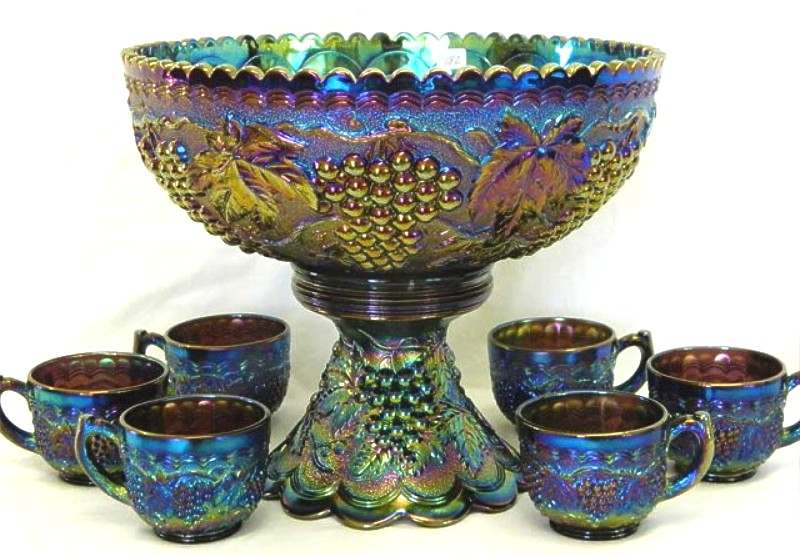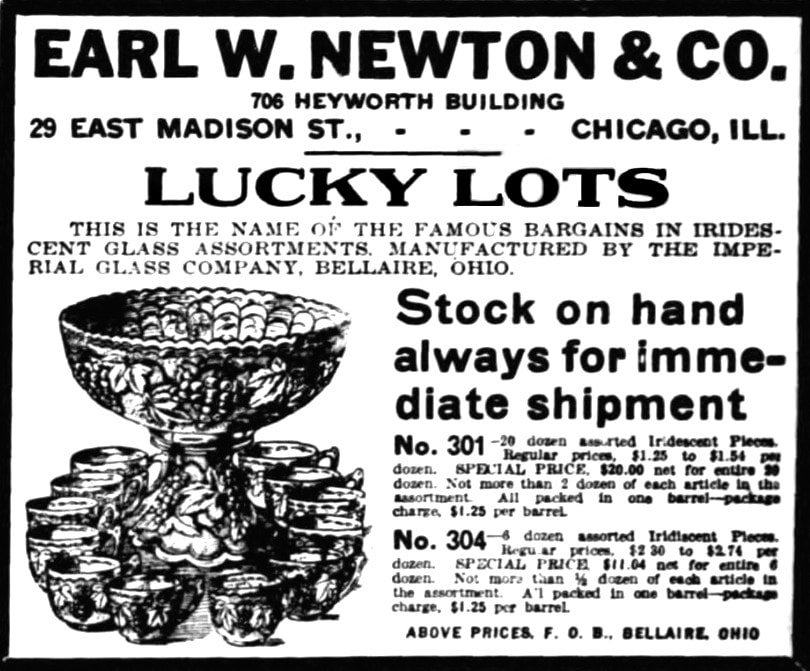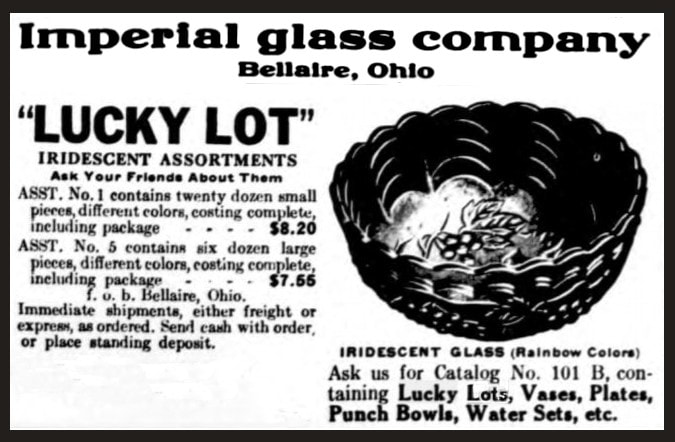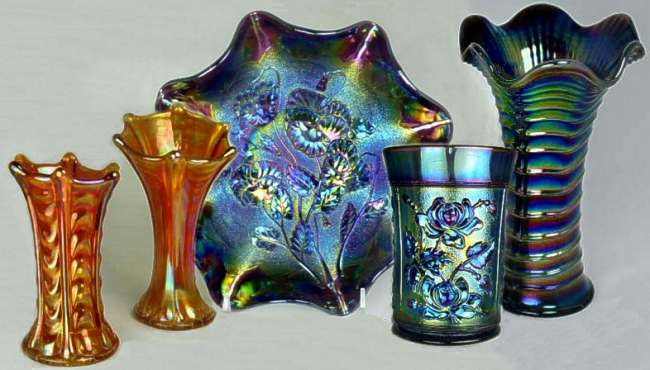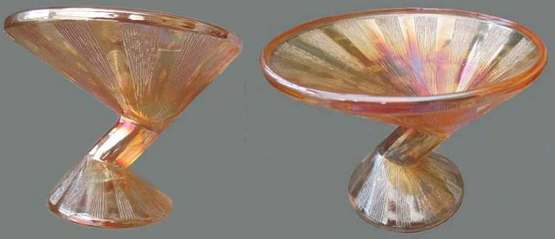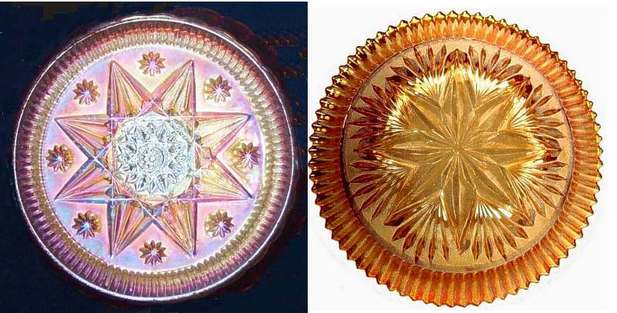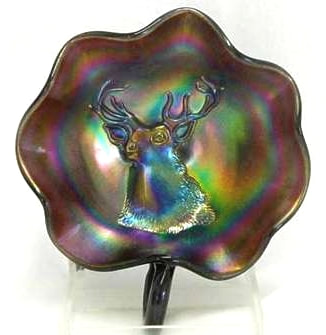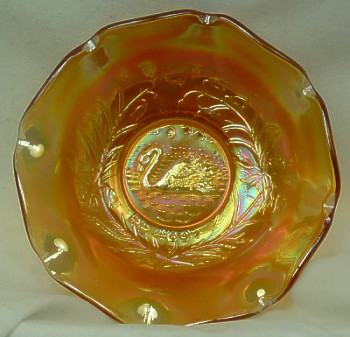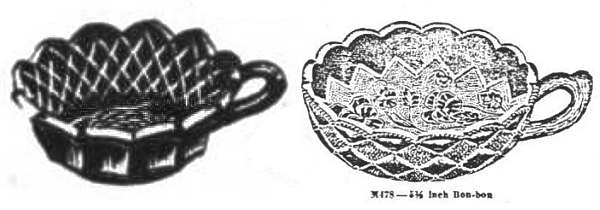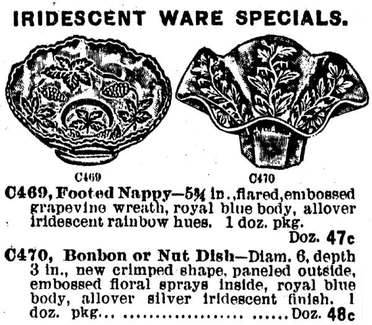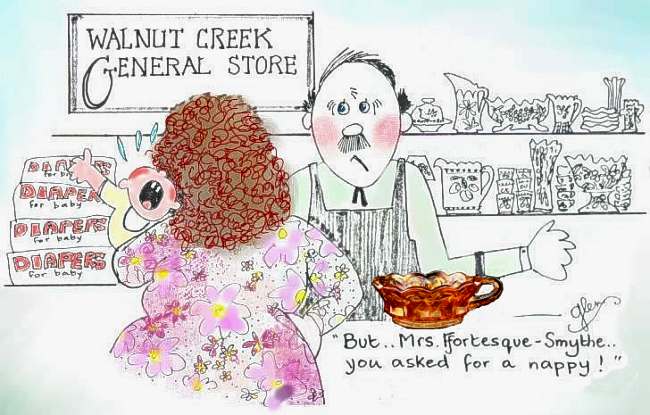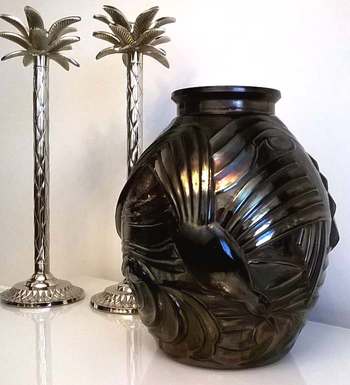NetworK ezine Issue 26. July 2017
Totally Devoted to Carnival Glass
|
Odds and Ends – Lucky Lots!
Has it ever crossed your mind why certain Carnival pieces seem to be more available than others? Or why you might struggle to find a piece to complete a set? You might even have a punch bowl in a different colour to the base, or mismatched tumblers in a water set. The answer might be LUCKY LOTS, which were “Bargain Assortments” put together by Imperial (and no doubt similar ones from other makers), as mentioned in these ads. |
It's possible that a lucky buyer would have received a set like this magnificent purple Imperial Grape punch set pictured aboveions), but as the ad says, this was by no means certain. The whole purpose of these lucky lots was that they were made up of an undefined assortment of "odds and ends" and mixed shapes and colours.
Here’s how Imperial described the reasoning behind their Lucky Lot Assortments in their 1915 Catalog 101B:
“Lucky Lots! The name is based upon our sincere conviction that you are lucky to get a chance to buy these lots. The reason for our willingness to make this special offer is to keep our stock clean by being able to ship every day the little lots of odds and ends which are developing every day in a factory like ours where the vast majority of goods are marketed in solid barrel lots, and packed up every day in solid barrel lots. Our idea is to pack up these small open lots and sell them at a reduced price, rather than keep them loose around our enormous packing room. The goods will, therefore, be very much assorted – assorted colors and assorted articles, sometimes in even quantities, at other times in uneven quantities”.
What would have been in those “Lucky Lots”?
Shown below is another ad from "The Billboard" in 1915. It gives us a little more detail – one assortment had “twenty dozen small pieces, different colors” while another had “six dozen large pieces, different colors”. It might have included bowls, vases, odd tumblers, tableware of all kinds, but crucially not in full or matching sets. Odds and ends, mis-matched colours and shapes - they were ideal for general stores or for the carnivals, where low cost was crucial.
Here’s how Imperial described the reasoning behind their Lucky Lot Assortments in their 1915 Catalog 101B:
“Lucky Lots! The name is based upon our sincere conviction that you are lucky to get a chance to buy these lots. The reason for our willingness to make this special offer is to keep our stock clean by being able to ship every day the little lots of odds and ends which are developing every day in a factory like ours where the vast majority of goods are marketed in solid barrel lots, and packed up every day in solid barrel lots. Our idea is to pack up these small open lots and sell them at a reduced price, rather than keep them loose around our enormous packing room. The goods will, therefore, be very much assorted – assorted colors and assorted articles, sometimes in even quantities, at other times in uneven quantities”.
What would have been in those “Lucky Lots”?
Shown below is another ad from "The Billboard" in 1915. It gives us a little more detail – one assortment had “twenty dozen small pieces, different colors” while another had “six dozen large pieces, different colors”. It might have included bowls, vases, odd tumblers, tableware of all kinds, but crucially not in full or matching sets. Odds and ends, mis-matched colours and shapes - they were ideal for general stores or for the carnivals, where low cost was crucial.
Above, on the left is an as from "The Billboard" in 1915, and on the right is a mixture of Imperial pieces that might easily have been included in a Lucky Lot: two Thin Rib and Drape vases (marigold), Pansy bowl, Lustre Rose tumbler and Ripple vase (all purple).
If you’d like to see more fascinating old ads from "The Billboard", and learn about the way in which Carnival Glass acquired its name, you might enjoy this article: What's in a Name?
If you’d like to see more fascinating old ads from "The Billboard", and learn about the way in which Carnival Glass acquired its name, you might enjoy this article: What's in a Name?
|
Shaken Not Stirred
The Martini - gin and vermouth, garnished with an olive or a lemon twist, and (according to James Bond) “shaken not stirred”. But what’s the connection with Carnival Glass? The answer is this splendid Deco-style, asymmetrical drinking glass that was found and named “Martini” by British collector, Nancy Young. Standing 4 inches high, and roughly the same measurement across, this elegant, marigold item has been a mystery regarding its maker … until we came across an almost identical item that had the moulded words LA ROCHERE FRANCE on its base. |
Our subsequent research has revealed what we believe is a previously un-recognised Carnival maker – the glassworks at La Rochère in France, one of the oldest in the country that is still producing both hand-made and pressed glass. You can now add La Rochère to your list of European Carnival Glass makers!
If you would like to read more about the fabulous Martini “coupe” (and find out what a “coupe” actually is), as well as discover the history of the glassworks at La Rochère, it's in our unique Collectors Facts feature: Martini
If you would like to read more about the fabulous Martini “coupe” (and find out what a “coupe” actually is), as well as discover the history of the glassworks at La Rochère, it's in our unique Collectors Facts feature: Martini
|
Seeing Stars
A veritable galaxy of Carnival Glass star patterns was featured on our NetworK Facebook. Collectors shared so many amazing images of their favourite star patterns from Carnival makers all over the world. Sowerby also featured, as we showed the intriguingly named “Lindisfarne” bowl, which has a massive, breathtaking hidden star. A true beauty, Lindisfarne was first shown in Sowerby’s catalogues in 1907, with the Carnival production probably following in the 1920s. A Sowerby star that wasn’t featured on our Facebook Group is the “Tyneside Star” – and it’s another star that is hidden away underneath. Turn over the plain looking bowl and you’ll stop in your tracks! |
Stars" from Sowerby. Left, Lindisfarne, and right, Tyneside Star. Both are exterior patterns.
|
Discover how Lindisfarne came to be named and read all about these unusual Sowerby pieces in our unique Collectors Facts Series. Here are the links:
Lindisfarne (Sowerby pattern #2240)
Tyneside Star (Sowerby pattern #2455)
Discover how Lindisfarne came to be named and read all about these unusual Sowerby pieces in our unique Collectors Facts Series. Here are the links:
Lindisfarne (Sowerby pattern #2240)
Tyneside Star (Sowerby pattern #2455)
So, what exactly is a "Nappy"?
The answer is not as simple as it may seem. Probably the most widely held belief is that a nappy (and we are talking about Carnival Glass, of course) is a small dish with a handle. Just one handle. If it has two handles, it’s a bonbon (or a card tray, but let’s not go down that road just yet – we’ll “handle” that puzzle another day). A nappy can be round, ruffled, or even heart or spade shaped, but the defining feature is that it has one handle.
The Elks piece illustrated below left is a good example of the nappy shape. It is a rare purple Elks nappy made by Dugan. Courtesy of Seeck Auctions.
But when these pieces were originally made they were not called nappies – in fact back in those early days, a nappy did not have a handle! Originally, a nappy was a simple, round shaped bowl, also called a sauce or even a berry bowl. That reflects the origins of the word “nappy” which was derived from various words meaning a rimless, small, open bowl (nap or knapf).
The answer is not as simple as it may seem. Probably the most widely held belief is that a nappy (and we are talking about Carnival Glass, of course) is a small dish with a handle. Just one handle. If it has two handles, it’s a bonbon (or a card tray, but let’s not go down that road just yet – we’ll “handle” that puzzle another day). A nappy can be round, ruffled, or even heart or spade shaped, but the defining feature is that it has one handle.
The Elks piece illustrated below left is a good example of the nappy shape. It is a rare purple Elks nappy made by Dugan. Courtesy of Seeck Auctions.
But when these pieces were originally made they were not called nappies – in fact back in those early days, a nappy did not have a handle! Originally, a nappy was a simple, round shaped bowl, also called a sauce or even a berry bowl. That reflects the origins of the word “nappy” which was derived from various words meaning a rimless, small, open bowl (nap or knapf).
In fact, Australian Carnival collectors maintain the original meaning today, using the word “nappy” for small berry bowls, such as the marigold Australian Swan item shown above on the right, made by Crown Crystal.
So what were the pieces with one handle called back in the early days?
So what were the pieces with one handle called back in the early days?
|
They were called olive dish, handled bon-bon or handled berry.
The Heavy Grape one-handled piece, below left, was called an “olive” dish in Imperial’s 1915 catalogue, and in their 1925 catalogue, they described the handled Pansy piece on the right, as a bon-bon. Today, many collectors refer to the shape as a nappy. To add to the "nappy" debate here is an ad from a 1912 Butler Bothers catalogue. The item on the left (C469), which is Fenton's Vintage, was called a nappy, but there is no handle to be seen! The item on the right (C470) is Fenton's Pepper Plant, described as a bonbon or nut dish, but today, collectors call it a "hat shape"!
|
|
Naturally, collectors find it convenient to give names to specific shapes, and hence today's generally accepted use of "nappy" for these small one-handled pieces. However, when they were originally made, a whole variety of names was used, often for the same shape.
The makers' intention was, of course, to give as many ideas as possible for the uses to which a particular item could be put - and ultimately, to increase sales. And if we want to complicate matters further, meanings of certain words are different around the world. In the UK a nappy is what would be called a diaper in the USA! In the British supermarket you’d find nappies in the Baby section. So, let’s sum it all up for clarity. Carnival collectors today usually use the term “nappy” to mean a small dish with one handle. Carnival collectors (especially in Australia) also use the term “nappy” to mean a small berry dish. But be careful of using the term “nappy” in the UK as you might get more than you bargained for! Read all about Carnival Glass shapes: Carnival Shapes |
|
Stop Press Here is an amazing new “find” just reported by collectors, John and Frances Hodgson. It is a deep purple (almost black) Seagulls vase, which was probably made by Libochovice in Czechoslovakia. Sincere thanks to John for this beautiful image of the vase. The Seagulls vase is one of several Art Deco style bulbous vases that have been found, including Giant Lily, Inca, and Pebble and Fan. They are very large and impressive pieces of Carnival Glass, and the known details about all them are to be found in our research article: Czech bulbous vases. |
Join us on Facebook
We invite you and your friends to join us all on NetworK's fast growing and very active Facebook Group - Carnival Glass NetworK. If you have missed any of the previous issues of NetworK and NetworK Specials, they are all on our Back Issues page.
We invite you and your friends to join us all on NetworK's fast growing and very active Facebook Group - Carnival Glass NetworK. If you have missed any of the previous issues of NetworK and NetworK Specials, they are all on our Back Issues page.

